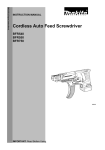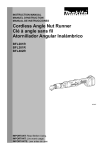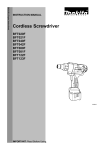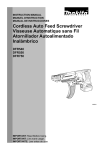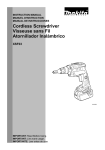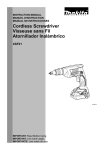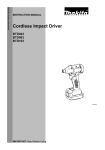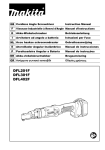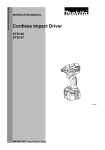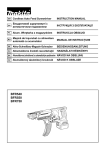Download Makita BFL082F Instruction manual
Transcript
ENGLISH (Original instructions) INSTRUCTION MANUAL Cordless Angle Screwdriver BFL061F BFL082F BFL122F BFL202F 013041 IMPORTANT: Read Before Using. 1 ENGLISH (Original instructions) SPECIFICATIONS Model Fastening torque BFL061F BFL082F BFL122F BFL202F Hard joint 1.5 - 6 N•m 2 - 8 N•m 5 - 12 N•m 8 - 20 N•m Soft joint 1.5 - 6 N•m 2 - 8 N•m 5 - 12 N•m 8 - 20 N•m Angle drive head 9.5 mm square or 6.35 mm hex No load speed (min-1) 470 Dimensions 700 410 220 422 x 74 x 98 mm (with Battery Cartridge BL1430) 405 x 74 x 98 mm (with Battery Cartridge BL1415) 1.7 kg (with Battery Cartridge BL1430) Net weight 1.5 kg (with Battery Cartridge BL1415) Rated voltage D.C. 14.4 V Battery cartridge BL1430 / BL1430A / BL1415 • Due to our continuing program of research and development, the specifications herein are subject to change without notice. • Specifications and battery cartridge may differ from country to country. • Weight, with battery cartridge, according to EPTA-Procedure 01/2003 END004-4 ENG900-1 Vibration The vibration total value (tri-axial vector sum) determined according to EN60745: Symbols The following show the symbols used for the equipment. Be sure that you understand their meaning before use. ・ Read instruction manual. Cd Ni-MH Li-ion ・ Work mode: screwdriving without impact Vibration emission (ah) : 2.5 m/s2 or less Uncertainty (K) : 1.5 m/s2 Only for EU countries Do not dispose of electric equipment or battery pack together with household waste material! In observance of European Directive 2002/96/EC on waste electric and electronic equipment, 2006/66/EC on batteries and accumulators and waste batteries and accumulators and their implementation in accordance with national laws, electric equipment and battery pack that have reached the end of their life must be collected separately and returned to an environmentally compatible recycling facility. ENG901-1 • • • • ENE033-1 Intended use The tool is intended for screw driving in wood, metal and plastic. ENG905-1 Noise The typical A-weighted noise level determined according to EN60745: Sound pressure level (LpA) : 70 dB(A) or less Uncertainty (K) : 3 dB(A) The noise level under working may exceed 80 dB(A) Wear ear protection 2 The declared vibration emission value has been measured in accordance with the standard test method and may be used for comparing one tool with another. The declared vibration emission value may also be used in a preliminary assessment of exposure. WARNING: The vibration emission during actual use of the power tool can differ from the declared emission value depending on the ways in which the tool is used. Be sure to identify safety measures to protect the operator that are based on an estimation of exposure in the actual conditions of use (taking account of all parts of the operating cycle such as the times when the tool is switched off and when it is running idle in addition to the trigger time). ENH101-16 3. Keep children and bystanders away while operating a power tool. Distractions can cause you to lose control. Electrical safety 4. Power tool plugs must match the outlet. Never modify the plug in any way. Do not use any adapter plugs with earthed (grounded) power tools. Unmodified plugs and matching outlets will reduce risk of electric shock. 5. Avoid body contact with earthed or grounded surfaces such as pipes, radiators, ranges and refrigerators. There is an increased risk of electric shock if your body is earthed or grounded. 6. Do not expose power tools to rain or wet conditions. Water entering a power tool will increase the risk of electric shock. 7. Do not abuse the cord. Never use the cord for carrying, pulling or unplugging the power tool. Keep cord away from heat, oil, sharp edges or moving parts. Damaged or entangled cords increase the risk of electric shock. 8. When operating a power tool outdoors, use an extension cord suitable for outdoor use. Use of a cord suitable for outdoor use reduces the risk of electric shock. 9. If operating a power tool in a damp location is unavoidable, use a ground fault circuit interrupter (GFCI) protected supply. Use of an GFCI reduces the risk of electric shock. Personal safety 10. Stay alert, watch what you are doing and use common sense when operating a power tool. Do not use a power tool while you are tired or under the influence of drugs, alcohol or medication. A moment of inattention while operating power tools may result in serious personal injury. 11. Use personal protective equipment. Always wear eye protection. Protective equipment such as dust mask, non-skid safety shoes, hard hat, or hearing protection used for appropriate conditions will reduce personal injuries. 12. Prevent unintentional starting. Ensure the switch is in the off-position before connecting to power source and/or battery pack, picking up or carrying the tool. Carrying power tools with your finger on the switch or energising power tools that have the switch on invites accidents. 13. Remove any adjusting key or wrench before turning the power tool on. A wrench or a key left attached to a rotating part of the power tool may result in personal injury. 14. Do not overreach. Keep proper footing and balance at all times. This enables better control of the power tool in unexpected situations. For European countries only EC Declaration of Conformity We Makita Corporation as the responsible manufacturer declare that the following Makita machine(s): Designation of Machine: Cordless Angle Screwdriver Model No./ Type: BFL061F, BFL082F, BFL122F, BFL202F are of series production and Conforms to the following European Directives: 2006/42/EC And are manufactured in accordance with the following standards or standardised documents: EN60745 The technical documentation is kept by: Makita International Europe Ltd. Technical Department, Michigan Drive, Tongwell, Milton Keynes, Bucks MK15 8JD, England 26.12.2011 000230 Tomoyasu Kato Director Makita Corporation 3-11-8, Sumiyoshi-cho, Anjo, Aichi, 446-8502, JAPAN GEA006-2 General Power Tool Safety Warnings WARNING Read all safety warnings and all instructions. Failure to follow the warnings and instructions may result in electric shock, fire and/or serious injury. Save all warnings and instructions for future reference. The term "power tool" in the warnings refers to your mains-operated (corded) power tool or battery-operated (cordless) power tool. Work area safety 1. Keep work area clean and well lit. Cluttered or dark areas invite accidents. 2. Do not operate power tools in explosive atmospheres, such as in the presence of flammable liquids, gases or dust. Power tools create sparks which may ignite the dust or fumes. 3 terminal to another. Shorting the battery terminals together may cause burns or a fire. 27. Under abusive conditions, liquid may be ejected from the battery; avoid contact. If contact accidentally occurs, flush with water. If liquid contacts eyes, additionally seek medical help. Liquid ejected from the battery may cause irritation or burns. Service 28. Have your power tool serviced by a qualified repair person using only identical replacement parts. This will ensure that the safety of the power tool is maintained. 29. Follow instruction for lubricating and changing accessories. 30. Keep handles dry, clean and free from oil and grease. 15. Dress properly. Do not wear loose clothing or jewellery. Keep your hair, clothing, and gloves away from moving parts. Loose clothes, jewellery or long hair can be caught in moving parts. 16. If devices are provided for the connection of dust extraction and collection facilities, ensure these are connected and properly used. Use of dust collection can reduce dust-related hazards. Power tool use and care 17. Do not force the power tool. Use the correct power tool for your application. The correct power tool will do the job better and safer at the rate for which it was designed. 18. Do not use the power tool if the switch does not turn it on and off. Any power tool that cannot be controlled with the switch is dangerous and must be repaired. 19. Disconnect the plug from the power source and/or the battery pack from the power tool before making any adjustments, changing accessories, or storing power tools. Such preventive safety measures reduce the risk of starting the power tool accidentally. 20. Store idle power tools out of the reach of children and do not allow persons unfamiliar with the power tool or these instructions to operate the power tool. Power tools are dangerous in the hands of untrained users. 21. Maintain power tools. Check for misalignment or binding of moving parts, breakage of parts and any other condition that may affect the power tool’s operation. If damaged, have the power tool repaired before use. Many accidents are caused by poorly maintained power tools. 22. Keep cutting tools sharp and clean. Properly maintained cutting tools with sharp cutting edges are less likely to bind and are easier to control. 23. Use the power tool, accessories and tool bits etc. in accordance with these instructions, taking into account the working conditions and the work to be performed. Use of the power tool for operations different from those intended could result in a hazardous situation. Battery tool use and care 24. Recharge only with the charger specified by the manufacturer. A charger that is suitable for one type of battery pack may create a risk of fire when used with another battery pack. 25. Use power tools only with specifically designated battery packs. Use of any other battery packs may create a risk of injury and fire. 26. When battery pack is not in use, keep it away from other metal objects, like paper clips, coins, keys, nails, screws or other small metal objects, that can make a connection from one GEB050-2 CORDLESS SCREWDRIVER SAFETY WARNINGS 1. 2. 3. 4. 5. Hold power tool by insulated gripping surfaces, when performing an operation where the fastener may contact hidden wiring. Fasteners contacting a "live" wire may make exposed metal parts of the power tool "live" and could give the operator an electric shock. Always be sure you have a firm footing. Be sure no one is below when using the tool in high locations. Hold the tool firmly. Keep hands away from rotating parts. Do not touch the bit or the workpiece immediately after operation; they may be extremely hot and could burn your skin. SAVE THESE INSTRUCTIONS. WARNING: DO NOT let comfort or familiarity with product (gained from repeated use) replace strict adherence to safety rules for the subject product. MISUSE or failure to follow the safety rules stated in this instruction manual may cause serious personal injury. ENC007-7 IMPORTANT SAFETY INSTRUCTIONS FOR BATTERY CARTRIDGE 1. 4 Before using battery cartridge, read all instructions and cautionary markings on (1) battery charger, (2) battery, and (3) product using battery. 2. 3. 4. 5. 6. 7. 8. 9. Do not disassemble battery cartridge. If operating time has become excessively shorter, stop operating immediately. It may result in a risk of overheating, possible burns and even an explosion. If electrolyte gets into your eyes, rinse them out with clear water and seek medical attention right away. It may result in loss of your eyesight. Do not short the battery cartridge: (1) Do not touch the terminals with any conductive material. (2) Avoid storing battery cartridge in a container with other metal objects such as nails, coins, etc. (3) Do not expose battery cartridge to water or rain. A battery short can cause a large current flow, overheating, possible burns and even a breakdown. Do not store the tool and battery cartridge in locations where the temperature may reach or exceed 50 ゚ C (122 ゚ F). Do not incinerate the battery cartridge even if it is severely damaged or is completely worn out. The battery cartridge can explode in a fire. Be careful not to drop or strike battery. Do not use a damaged battery. FUNCTIONAL DESCRIPTION • Installing or removing battery cartridge 2 3 013042 CAUTION: Always switch off the tool before installing or removing of the battery cartridge. • Hold the tool and the battery cartridge firmly when installing or removing battery cartridge. Failure to hold the tool and the battery cartridge firmly may cause them to slip off your hands and result in damage to the tool and battery cartridge and a personal injury. To remove the battery cartridge, slide it from the tool while sliding the button on the front of the cartridge. To install the battery cartridge, align the tongue on the battery cartridge with the groove in the housing and slip it into place. Insert it all the way until it locks in place with a little click. If you can see the red indicator on the upper side of the button, it is not locked completely. • Tips for maintaining maximum battery life 2. 3. 4. 1. Red indicator 2. Button 3. Battery cartridge 1 SAVE THESE INSTRUCTIONS. 1. CAUTION: Always be sure that the tool is switched off and the battery cartridge is removed before adjusting or checking function on the tool. Charge the battery cartridge before completely discharged. Always stop tool operation and charge the battery cartridge when you notice less tool power. Never recharge a fully charged battery cartridge. Overcharging shortens the battery service life. Charge the battery cartridge with room temperature at 10 ゚ C - 40 ゚ C (50 ゚ F - 104 ゚ F). Let a hot battery cartridge cool down before charging it. Charge the battery cartridge once in every six months if you do not use it for a long period of time. • • 5 CAUTION: Always install the battery cartridge fully until the red indicator cannot be seen. If not, it may accidentally fall out of the tool, causing injury to you or someone around you. Do not install the battery cartridge forcibly. If the cartridge does not slide in easily, it is not being inserted correctly. Reversing switch action Battery remaining capacity indicator (only for models with Battery BL1430A) 1. Reversing switch lever A Battery BL1430A is equipped with the battery remaining capacity indicator. Checking the remaining battery capacity 1 B 003618 CAUTION: Always check the direction of rotation before operation. • Use the reversing switch only after the tool comes to a complete stop. Changing the direction of rotation before the tool stops may damage the tool. • When not operating the tool, always set the reversing switch lever to the neutral position. This tool has a reversing switch to change the direction of rotation. Depress the reversing switch lever from the A side for clockwise rotation or from the B side for counterclockwise rotation. When the reversing switch lever is in the neutral position, the switch trigger cannot be pulled. • 008971 When charging When the charging begins, the first (far left) indicating lamp begins to flicker. Then, as charging proceeds, the other lamps light, one after the other, to indicate the battery capacity. When using When the tool is switched on, the lamps will light to indicate the remaining battery capacity. When the tool is switched off, the light goes out after approx. 5 seconds. When the tool is used with the battery that has not been used for a long time and is switched on, no lamps may not light up at all. Use Makita refreshing adapter to refresh the battery. Lighting up the lamps 1. Lamp 2. LED indicator 2 Switch action 1. Switch trigger 1 003619 CAUTION: Do not look in the light or see the source of light directly. Pull the switch trigger to light up the lamp. The lamp keeps on lighting while the switch trigger is being pulled. The light automatically goes out 10 seconds after the switch trigger is released. 1 • 003617 CAUTION: Before inserting the battery cartridge into the tool, always check to see that the switch trigger actuates properly and returns to the "OFF" position when released. To start the tool, simply pull the switch trigger. Release the switch trigger to stop. • NOTE: • Use a dry cloth to wipe the dirt off the lens of lamp. Be careful not to scratch the lens of lamp, or it may lower the illumination. 6 LED indicator / Beeper Led indicator / Beeper on the tool shows the following functions. Status of the LED indicator/beeper Function Status Action to be taken LED indicator Auto-stop fastening Delayed re-start This function works when the tool has reached the preset fastening torque and normal tightening has been completed. This helps Lights up in green for overtightening to be avoided. approximately one second. For approximately one second after auto-stop fastening, the tool does not start even if the switch trigger is pulled. Insufficient fastening has been performed Warning against when the switch trigger has released before insufficient fastening reaching the preset fastening torque. Beeper - Lights up in red. A long beep - Retighten the screw. Warning for battery cartridge capacity This indicates the appropriate time to replace the battery cartridge when the battery power becomes low. Flickers in red slowly. Replace the battery A series of long with fully charged beeps one. Checking the remaining battery capacity, Autostop This function works when the battery power is almost used up. At this time, tool stops immediately. Lights up in red. A long beep Check the LED indicator, lamp and beeper operation This function works to check the proper operation of the LED indicator, lamp and beeper when a battery cartridge has been inserted into the tool. Lights up first in green, next red. A series of very (And then the lamp short beeps comes on.) Anti-reset of controller This function works when an abnormal drop of the battery voltage occurs for some reason, and the tool stops. Flickers in red and green alternatively. Replace the battery A series of short with fully charged beeps one. Overheat This function works when the temperature of the controller goes up very highly, and the tool stops. Flickers in red quickly. Remove the battery A series of short cartridge immediately and cool the tool beeps down. Operation error of the switch trigger This function works to avoid the tool's immediate start upon insertion of battery cartridge into the tool with the switch trigger being pulled. Flickers in red and green alternatively. A series of short Release the switch trigger. beeps Warning for limit of the fastening capacity The tool automatically stops without the clutch Flickers in red and working when exceeding the fastening capacity green alternatively. limit. 013073 7 Replace the battery with fully charged one. - Remove the battery cartridge and then A series of short install it again. beeps Be sure to use the tool under load within its capacity. Adjusting the fastening torque ASSEMBLY 1. Adjusting grip 2. Ring 1 • CAUTION: Always be sure that the tool is switched off and the battery cartridge is removed before carrying out any work on the tool. Selecting correct socket or screw bit There are different types of sockets or bits for some models depending on applications. Choose and install a correct socket or bit for your application. 2 013070 When you wish to drive machine screws, wood screws, hex bolts, etc. with the predetermined torque, adjusting the fastening torque as follows. 1. First remove the battery cartridge from the tool. 2. Loosen the screws securing the lamp cover. 3. Rotate the ring in the front of the tool by hand so that a hole can be seen below the ring. 4. Place the battery cartridge in place and pull the switch trigger. Release it so that the adjusting ring rotates and becomes visible in the hole. And then remove the battery cartridge. Installing or removing socket 1. Socket 2. Hole 3. Pin 1 2 3 003623 1 5 2 3 6 4 8 7 To install the socket, push it onto the square drive of the tool with one hand by depressing a pin on the square drive with another hand until it locks into place. To remove the socket, simply pull it off depressing the pin on the square drive. 1. Angle head 2. Adjusting ring 3. Ring 4. Scale 5. Adjusting grip 6. Hole for adjusting grip 7. Yellow line 8. Compression spring Installing or removing bit 1 013090 5. 6. 7. 8. 9. Use an optional adjusting grip to adjust the fastening torque. Insert the pin of the adjusting grip into the hole in the front of the tool. And then, turn the adjusting grip clockwise to set a greater fastening torque, and counterclockwise to set a smaller fastening torque. Align the edge of the adjusting ring with your desired number on the fastening torque scale. Align the yellow line with your desired number on the fastening torque scale. Insert the battery cartridge and be sure that a fastening torque has been set up by using a fastening torque tester. Tighten the screws to secure the lamp cover and then rotate the ring in front of the tool until the ring is locked. 1. Screw bit 2. Sleeve 2 004170 For tools with retracting sleeve To install the bit, pull the sleeve in the direction of the arrow and insert the bit into the sleeve as far as it will go. Then release the sleeve to secure the bit. To remove the bit, pull the sleeve in the direction of the arrow and pull the bit out firmly. For tools without retracting sleeve To install the bit, just insert the bit into the spindle as far as it will go. To remove the bit, pull the bit out firmly. NOTE: • Numbers on the fastening torque scale is a guideline to set up your desired fastening torque. 8 OPERATION Hold the tool firmly and place the socket over the bolt or nut. Then switch the tool on. When the clutch cuts in, the motor will stop automatically. Then release the switch trigger. 1 2 NOTE: • Hold the tool with its square drive pointed straight at the bolt or nut, or the bolt or nut will be damaged. 003628 Use a screwdriver to remove the brush holder caps. Take out the worn carbon brushes, insert the new ones and secure the brush holder caps. To maintain product SAFETY and RELIABILITY, repairs, any other maintenance or adjustment should be performed by Makita Authorized Service Centers, always using Makita replacement parts. Limits of fastening capacity Use the tool within the range of the revolution angle up to 360 ゚. If you use the tool beyond the upper limit of this range, the clutch does not work. And the tool cannot deliver enough fastening torque (LED flickers in red and green alternatively). OPTIONAL ACCESSORIES NOTE: • The revolution angle means the angle which a screw/bolt revolves when the tool attains to 100% from 50% of desired torque. • Use of a low temperature conditioned battery cartridge may sometimes give warning for battery cartridge capacity by warning lamp and beeper which makes the tool stop immediately. In this case, the fastening capacity may be inferior to the specification on this manual even if a charged battery cartridge is used. CAUTION: These accessories or attachments are recommended for use with your Makita tool specified in this manual. The use of any other accessories or attachments might present a risk of injury to persons. Only use accessory or attachment for its stated purpose. If you need any assistance for more details regarding these accessories, ask your local Makita Service Center. • Protector • Makita genuine battery and charger • Angle head set • Adjusting grip • Anti kickback head • MAINTENANCE • • 1. Screwdriver 2. Brush holder cap CAUTION: Always be sure that the tool is switched off and the battery cartridge is removed before attempting to perform inspection or maintenance. Never use gasoline, benzine, thinner, alcohol or the like. Discoloration, deformation or cracks may result. NOTE: • Some items in the list may be included in the tool package as standard accessories. They may differ from country to country. Replacing carbon brushes 1. Limit mark 1 001145 Remove and check the carbon brushes regularly. Replace when they wear down to the limit mark. Keep the carbon brushes clean and free to slip in the holders. Both carbon brushes should be replaced at the same time. Use only identical carbon brushes. 9 10 11 Makita Corporation Anjo, Aichi, Japan 885144A221 12 www.makita.com












